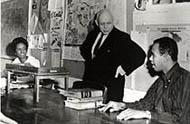- From Swastika to Jim Crow
Infobox Film
name = From Swastika to Jim Crow

image_size = 150px
caption =
director =Lori Cheatle andMartin D. Toub
producer =Steven Fischler andJoel Sucher
writer =Gabrielle Simon Edgcomb (book)
narrator =Luc Sante
starring =
music =
cinematography =
editing =
distributor =
released = 2000
runtime = 60 min.
country =
language = English
budget =
preceded_by =
followed_by =
website = http://www.pbs.org/itvs/fromswastikatojimcrow/
amg_id =
imdb_id =0231617"From Swastika to Jim Crow" is a 2000 documentary that explores the similarities between
Nazism inGermany (theSwastika ) andracism in the American south (Jim Crow). In 1939, the Nazi government expelledJewish scholars from German universities. Many of them found teaching positions in Southern Universities, where they sympathized with the plight of theirAfrican-American colleagues and students.ummary
The horrors of
prejudice became a common thread that could bind these exiled Jewish professors with their black students and colleagues. The film pairs shocking archival footage of theKKK dressed in costume and carrying torches with footage ofNazi salutes and marching German soldiers to compare the barbarity of both ideologies. A picture of a lynching shows a mob of average white citizens standing around casually and looking up at the tree, while photographs of theHolocaust depict emaciated corpses piled on top of each other.Showing the similarities between Germananti-Semitism and Southern racism through a rich compilation of interviews, archival film footage, and photographs, "From Swastika to Jim Crow" shows that bothAfrican American students and their Jewish professors were familiar withprejudice and felt isolated fromEuropean American southern society. Their common understanding bonded them together to create a safe haven of interracial, intellectual dialogue and friendship.When Germany forced it's Jewish intellectuals to flee, America embraced high-profile thinkers like
Albert Einstein , but the vast majority of lesser-known Jewish intellectual refugees struggled in America. Not only were jobs scarce because of the Depression, but prevalent anti-Semitism and anti-German sentiments meant the decision to take teaching jobs in the South was not based on the prestige of the positions, but rather because African American schools had the only slots available to these normally discriminated againstGerman Jews .These Jewish professors brought their proper German teaching style with them to America. They approached the classroom with strict formality, wearing full suits and insisting that students rise when answering questions. Although their students were not accustomed to being treated with such formality in the classroom, with time they grew fond of their professor's quirks.
In addition to developing relationships with African-Americans, these Jewish professors often served as a bridge between the African-American and European American communities. In one instance, a professor organized a dinner with both African-American and European American families. He asked the African-American guests, who arrived first, to sit in every other chair, so that when the European American guests arrived they would be forced to interact with one another. The professor knew he couldn't force people to give up their prejudice, but he was committed to doing whatever he could to encourage tolerance.
Through these simple acts, these Jewish intellectuals planted seeds that developed into the
Civil Rights movement . By treating their African American students with the respect and dignity they deserved, Jewish professors acted as catalysts for forward thinking that recognizes all citizens as equals.About the filmmakers
*Producers Steven Fischerler and Joel Sucher have produced a number of award-winning documentary films based on historical, cultural and political topics. They've received the
Guggenheim Fellowship in film,Emmy Award s, Cine Golden Eagles, and theJohn Grierson Award for Social Documentaries.*Director Lori Cheatle's films have been produced by
PBS ,Lifetime Television , andParamount Pictures . She has worked on a number of films, her most recent being, "Dashiell Hammett: Detective Writer".*Martin D. Toub has directed, photographed and edited for Pacific Street productions since 1986. Among other films, he worked on "
Martin Scorsese Directs" (PBS 1991) and "Oliver Stone : Inside/Out" (BBC , 1993).Production
"From Swastika to Jim Crow" was inspired by a "
New York Times " editorial. The letter writer was upset by the fact thatantisemitic sentiment was being spouted by speech givers atHoward University and other predominantly African-American schools. The editorialist mentioned the book "From Swastika to Jim Crow" and lamented the past, when Jewish professors found refuge at Southern universities. The filmmakers were intrigued, bought the book, and began immediately planning their documentary. cite web
title =From Swastika to Jim Crow
publisher =ITVS
date =October 17 200
url =http://www.itvs.org/pressroom/pressRelease.htm?pressId=72
accessdate = 8 AugustNotes
References
*cite web
last =
first =
authorlink =
coauthors =
title =From Swastika to Jim Crow
work =
publisher =PBS.org
date =
url =http://www.pbs.org/itvs/fromswastikatojimcrow/
accessdate =8 August
*cite web
title ='From Swastika to Jim Crow' Improving Black-Jewish Relations
work =
publisher =Anti-Defamation League
date =2002
url =http://www.adl.org/education/swastika_themes.asp
accessdate =8 August*cite web
title =From Swastika to Jim Crow
publisher =ITVS
date =October 17 200
url =http://www.itvs.org/pressroom/pressRelease.htm?pressId=72
accessdate = 8 Augustee also
*
History of Jews in the United States
*History of antisemitism Other films about Jews in America:
*"
My Yiddish Momme McCoy "
*"Awake Zion "
*"Professional Revolutionary "
*"Song of a Jewish Cowboy "
*"A Home on the Range "External links
* [http://www.tau.ac.il/Anti-Semitism/ Anti-Semitism and Racism]
* [http://tjctv.com/?p=202 "The Jewish Channel's" review of "From Swastika to Jim Crow"]
Wikimedia Foundation. 2010.
